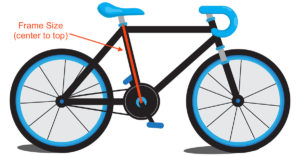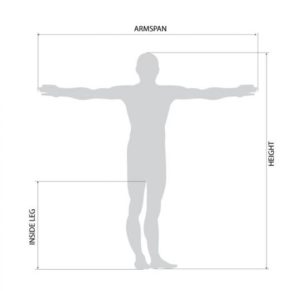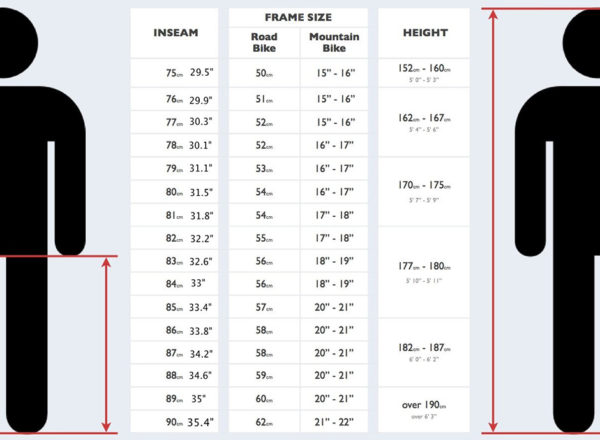People come in all shapes and sizes, so it makes sense that bikes do to. It’s not impossible to make the wrong sized bike work for you, but it’s definitely easier to purchase a bike that is your size from the get-go.
When you’re first getting into cycling, it’s tempting to go with a second hand bike that’s the right price rather than the right fit. However, as great as it is to get discounted bikes, the problems begin when you actually start riding. From overall comfort and enjoyment to your own safety, having the right size bike can make all the difference.
If you’re looking to get into cycling, or don’t think your current bike is right for you, this guide will help you find the perfect fit.

Decide what kind of bike you want
When it comes to buying a new bike, it can be overwhelming with all the options out there. First thing, you need to decide what type of bike you want. Are you going to be riding on trails, road, or a little bit of both? Generally speaking, there are two main types of bikes: road bikes and mountain bikes. However, within those types there is a wide range, as well as cross bikes that bridge the gap between the two. Sizing can differ dependent on the type of bike.
Why does bike size matter?
If you’re a casual rider and aren’t going out on long distance rides, bike size and a proper fit may not be a huge deal. But as the kilometers start to fly by the more you get into cycling, the millimeters of a bike frame start to matter. Why? There are three main reasons:
- Comfort – If you are uncomfortable on your bike, then you’re not going to want to ride it – sometimes it’s that simple. Feeling comfortable on a bike is your first step towards ensuring it is the right size for you.
- Injury prevention – If a bike frame is too big or too small for you, there are many issues that can come up. For example, if the bike is too big for you, your torso will be overextended, causing a rocking in the lower back that can lead to pain and serious injury. Cycling is one of the best types of exercise for you body, but if you don’t have the right bike, it cause more harm than good in the long run.
- Maximize efficiency – Who doesn’t want to go faster with less effort? Ensuring you are in the correct position on the right size bike helps you make the most of every rotation, as you won’t be wasting any energy.
How are bikes measured?

There are two basic measurement systems: by size (small, medium, large) and by measurement (in centimetres). Both systems are based on the metal frame of the bike, as the added components (handlebars, saddles, etc) are interchangeable.
Generally, frames are measured by the distance from the centre of the bottom bracket to the top of the seat tube (see diagram below). However, the method of measurement can vary between manufacturers as they each have their own approach to bike design.
Bike sizing vs. bike fitting
They may sound like the same thing, but bike sizing and fitting are actually two entirely different things. For the sake of this article, we are focusing on bike sizing, which is fitting you, as a rider, to the bike.
An in-depth bike fitting is a great idea, but only once you have the base of your bike size. From there you can further adjust all the little things like handle bars, saddle, and pedal position – essentially fitting the bike to you.
How to determine your frame size
There are a ton of online calculators that can help you get an idea of your frame size, but won’t necessarily give you the whole picture. Two people can be the same height, while having different length legs and torso.
Bike size is determined by three main measurements:
- Your height – This is not the time to round up your 5”11 to 6”0, so be sure to get an accurate measure of your standing height.
- Inseam length – This refers to the distance from your crotch to the end of your pant leg and determines your standover height (so you can comfortably stand over the crossbar). You’ll need about 1-3 inches of wiggle room between the crossbar and your crotch.
- Your reach – Measured by the “Ape index,” your reach is your arm span compared to your height. It is calculated by subtracting your height from your arm span (measured from fingertip to fingertip). If a positive number, your arm span is greater than your height (and perhaps you should pick up rock climbing). If a negative number, your height is greater than your arm span.
A general sizing guide
The following chart shows a general guide to bike sizing in regards to your height and inseam length.

If you go into your local bike shop, they should help you with all these measurements and get you onto the appropriately sized bike, but it’s not a bad idea to go in with an idea of what will work for you. It’s not worth impulse buying the wrong size bike because it’s on sale or catches your eye! Make sure you take the time to try out a bike before buying when possible, and a thorough bike fitting is always a good idea.